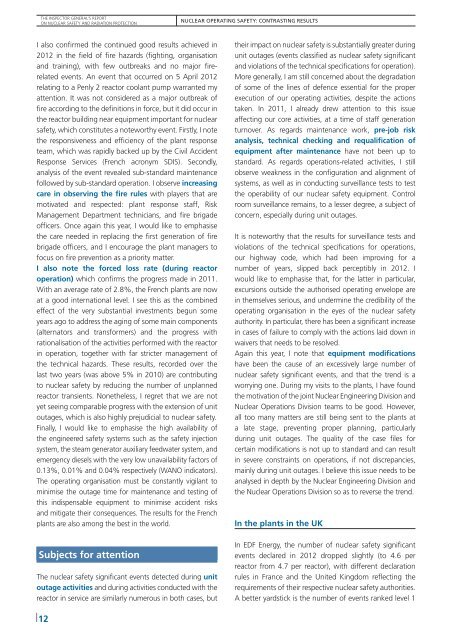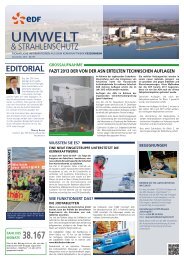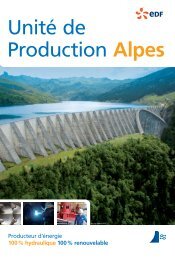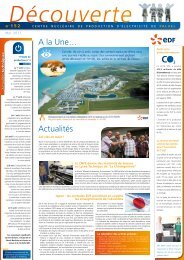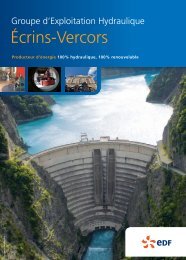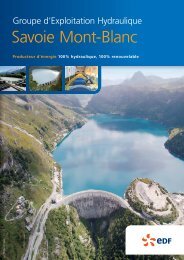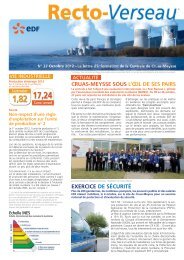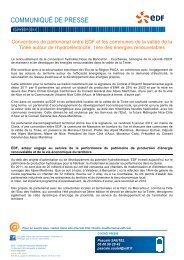on Nuclear Safety and Radiation Protection - Energie EDF
on Nuclear Safety and Radiation Protection - Energie EDF
on Nuclear Safety and Radiation Protection - Energie EDF
Create successful ePaper yourself
Turn your PDF publications into a flip-book with our unique Google optimized e-Paper software.
THE INSPECTOR GENERAL’S REPORT<br />
ON NUCLEAR SAFETY AND RADIATION PROTECTION<br />
I also c<strong>on</strong>firmed the c<strong>on</strong>tinued good results achieved in<br />
2012 in the field of fire hazards (fighting, organisati<strong>on</strong><br />
<strong>and</strong> training), with few outbreaks <strong>and</strong> no major firerelated<br />
events. An event that occurred <strong>on</strong> 5 April 2012<br />
relating to a Penly 2 reactor coolant pump warranted my<br />
attenti<strong>on</strong>. It was not c<strong>on</strong>sidered as a major outbreak of<br />
fire according to the definiti<strong>on</strong>s in force, but it did occur in<br />
the reactor building near equipment important for nuclear<br />
safety, which c<strong>on</strong>stitutes a noteworthy event. Firstly, I note<br />
the resp<strong>on</strong>siveness <strong>and</strong> efficiency of the plant resp<strong>on</strong>se<br />
team, which was rapidly backed up by the Civil Accident<br />
Resp<strong>on</strong>se Services (French acr<strong>on</strong>ym SDIS). Sec<strong>on</strong>dly,<br />
analysis of the event revealed sub-st<strong>and</strong>ard maintenance<br />
followed by sub-st<strong>and</strong>ard operati<strong>on</strong>. I observe increasing<br />
care in observing the fire rules with players that are<br />
motivated <strong>and</strong> respected: plant resp<strong>on</strong>se staff, Risk<br />
Management Department technicians, <strong>and</strong> fire brigade<br />
officers. Once again this year, I would like to emphasise<br />
the care needed in replacing the first generati<strong>on</strong> of fire<br />
brigade officers, <strong>and</strong> I encourage the plant managers to<br />
focus <strong>on</strong> fire preventi<strong>on</strong> as a priority matter.<br />
I also note the forced loss rate (during reactor<br />
operati<strong>on</strong>) which c<strong>on</strong>firms the progress made in 2011.<br />
With an average rate of 2.8%, the French plants are now<br />
at a good internati<strong>on</strong>al level. I see this as the combined<br />
effect of the very substantial investments begun some<br />
years ago to address the aging of some main comp<strong>on</strong>ents<br />
(alternators <strong>and</strong> transformers) <strong>and</strong> the progress with<br />
rati<strong>on</strong>alisati<strong>on</strong> of the activities performed with the reactor<br />
in operati<strong>on</strong>, together with far stricter management of<br />
the technical hazards. These results, recorded over the<br />
last two years (was above 5% in 2010) are c<strong>on</strong>tributing<br />
to nuclear safety by reducing the number of unplanned<br />
reactor transients. N<strong>on</strong>etheless, I regret that we are not<br />
yet seeing comparable progress with the extensi<strong>on</strong> of unit<br />
outages, which is also highly prejudicial to nuclear safety.<br />
Finally, I would like to emphasise the high availability of<br />
the engineered safety systems such as the safety injecti<strong>on</strong><br />
system, the steam generator auxiliary feedwater system, <strong>and</strong><br />
emergency diesels with the very low unavailability factors of<br />
0.13%, 0.01% <strong>and</strong> 0.04% respectively (WANO indicators).<br />
The operating organisati<strong>on</strong> must be c<strong>on</strong>stantly vigilant to<br />
minimise the outage time for maintenance <strong>and</strong> testing of<br />
this indispensable equipment to minimise accident risks<br />
<strong>and</strong> mitigate their c<strong>on</strong>sequences. The results for the French<br />
plants are also am<strong>on</strong>g the best in the world.<br />
Subjects for attenti<strong>on</strong><br />
The nuclear safety significant events detected during unit<br />
outage activities <strong>and</strong> during activities c<strong>on</strong>ducted with the<br />
reactor in service are similarly numerous in both cases, but<br />
12<br />
NUCLEAR OPERATING SAFETY: CONTRASTING RESULTS<br />
their impact <strong>on</strong> nuclear safety is substantially greater during<br />
unit outages (events classified as nuclear safety significant<br />
<strong>and</strong> violati<strong>on</strong>s of the technical specificati<strong>on</strong>s for operati<strong>on</strong>).<br />
More generally, I am still c<strong>on</strong>cerned about the degradati<strong>on</strong><br />
of some of the lines of defence essential for the proper<br />
executi<strong>on</strong> of our operating activities, despite the acti<strong>on</strong>s<br />
taken. In 2011, I already drew attenti<strong>on</strong> to this issue<br />
affecting our core activities, at a time of staff generati<strong>on</strong><br />
turnover. As regards maintenance work, pre-job risk<br />
analysis, technical checking <strong>and</strong> requalificati<strong>on</strong> of<br />
equipment after maintenance have not been up to<br />
st<strong>and</strong>ard. As regards operati<strong>on</strong>s-related activities, I still<br />
observe weakness in the c<strong>on</strong>figurati<strong>on</strong> <strong>and</strong> alignment of<br />
systems, as well as in c<strong>on</strong>ducting surveillance tests to test<br />
the operability of our nuclear safety equipment. C<strong>on</strong>trol<br />
room surveillance remains, to a lesser degree, a subject of<br />
c<strong>on</strong>cern, especially during unit outages.<br />
It is noteworthy that the results for surveillance tests <strong>and</strong><br />
violati<strong>on</strong>s of the technical specificati<strong>on</strong>s for operati<strong>on</strong>s,<br />
our highway code, which had been improving for a<br />
number of years, slipped back perceptibly in 2012. I<br />
would like to emphasise that, for the latter in particular,<br />
excursi<strong>on</strong>s outside the authorised operating envelope are<br />
in themselves serious, <strong>and</strong> undermine the credibility of the<br />
operating organisati<strong>on</strong> in the eyes of the nuclear safety<br />
authority. In particular, there has been a significant increase<br />
in cases of failure to comply with the acti<strong>on</strong>s laid down in<br />
waivers that needs to be resolved.<br />
Again this year, I note that equipment modificati<strong>on</strong>s<br />
have been the cause of an excessively large number of<br />
nuclear safety significant events, <strong>and</strong> that the trend is a<br />
worrying <strong>on</strong>e. During my visits to the plants, I have found<br />
the motivati<strong>on</strong> of the joint <strong>Nuclear</strong> Engineering Divisi<strong>on</strong> <strong>and</strong><br />
<strong>Nuclear</strong> Operati<strong>on</strong>s Divisi<strong>on</strong> teams to be good. However,<br />
all too many matters are still being sent to the plants at<br />
a late stage, preventing proper planning, particularly<br />
during unit outages. The quality of the case files for<br />
certain modificati<strong>on</strong>s is not up to st<strong>and</strong>ard <strong>and</strong> can result<br />
in severe c<strong>on</strong>straints <strong>on</strong> operati<strong>on</strong>s, if not discrepancies,<br />
mainly during unit outages. I believe this issue needs to be<br />
analysed in depth by the <strong>Nuclear</strong> Engineering Divisi<strong>on</strong> <strong>and</strong><br />
the <strong>Nuclear</strong> Operati<strong>on</strong>s Divisi<strong>on</strong> so as to reverse the trend.<br />
In the plants in the UK<br />
In <strong>EDF</strong> Energy, the number of nuclear safety significant<br />
events declared in 2012 dropped slightly (to 4.6 per<br />
reactor from 4.7 per reactor), with different declarati<strong>on</strong><br />
rules in France <strong>and</strong> the United Kingdom reflecting the<br />
requirements of their respective nuclear safety authorities.<br />
A better yardstick is the number of events ranked level 1


